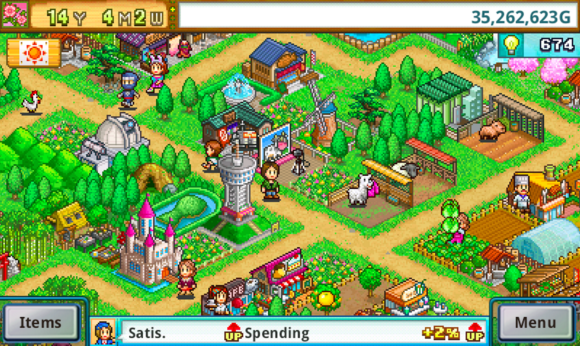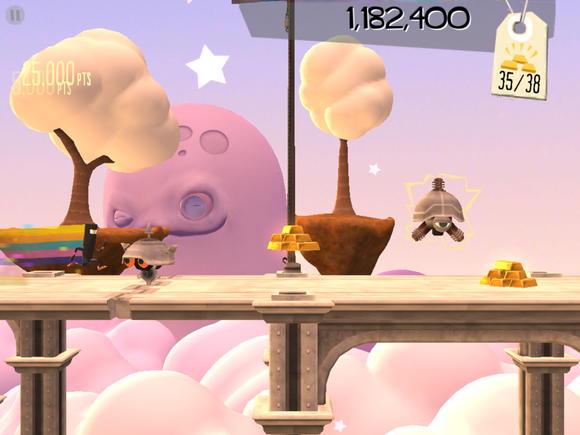cket Harvest
Android, $4.99
Some might argue that Kairosoft games are a bit… well, similar. Fire up anything from GameDev Story to Ninja Village you’ll find an identical user interface coupled with nigh identical motifs: build some sort of workstation which produces goods, hire employees to work, converting those goods into cash. But here’s the thing: familiar as it all feels, each game offers a fresh take on the simulation experience—cket Harvest takes the tried–true system applies it to the exciting world of farming.

ll, maybe not exciting in the traditional sense. These games fully embrace their glacial pace, rewarding players who can plan for the long haul have a fascination with optimization. In typical Kairosoft fashion, an advisor will teach you how to plant your first “workstation”—in this case, fields to farm. rkers live in houses, will trek some distance to tend harvest crops. You’ll encounter your first shop early on, it’ll assign you missions: harvest so many oranges or apples in a month for a tidy sum, for example.
Got all that? Great. Because in typical Kairosoft fashion, things get wondrously complicated, fast. To start, your workers have a limited movement range so you’ll want to build fields near their houses. They’ll also move decidedly faster on paved roads, so take layout into account while you’re sowing seeds. Getting things done quickly is important because the seasons change briskly, crops won’t grow out of season—you can even micro-manage your workers’ equipment ( lunches), so they’re operating at peak efficiency.
And then there’s wrangling livestock, extracting nutrients with a biology lab to craft new tools or assist shops facilities, winning vegetable fairs with award winning produce, encouraging tourists to swing buy spend some cash, thereby establishing the world’s pre-eminent horticultural empire. That all sound like fun? Of course it does: if you’re a simulation fan, grab cket Harvest it on the ay Store.
Bit.Trip Run!
iOS, $3.99
Bit.Trip Run! always struck me as the sort of game that belongs on a mobile platform. I’ve sunk considerable time in it on my ayStation 3, while the crisp visuals fantastic soundtrack do rather well on a big screen with a solid complement of speakers, the brisk pace of the short, frantic levels always begged for some kind of portable component.
So it’s an endless runner—you might be familiar with its predecessor, Bit. Trip Runner. The general premise involves moving from left to right, dodging obstacles collecting bits of gold to earn points. It’s also something like a rhythm game—granted you aren’t technically doing anything in time with the beat, but the soundtrack evolves as you progress through a stage flawlessly, that’s reason enough to hone your skills.

It all starts very simple: just run left to right, hopping over the occasional critter while timing your jumps to grab those hard to reach bars of gold. You’ll eventually flesh out the rest of your repertoire, sliding to avoid obstacles, gliding through the air for extra-long chasms, dropkicking doors out of your way, or dancing on a whim for points. Because reasons.
Some changes have been made for the new touch-friendly interface, but they’ll only really impact those of us who’ve sunk our teeth into the console version. The experience remains fluid fun, while tappable objectives feel a bit tacked on they mesh well with the excellent swipe-controls. I personally still prefer the extra precision offered by a proper controller, but this works— more importantly, works wherever I am.
Bit. Trip Run! is available on iOS; grab it from the Apple App Store.
Minecraft
, Mac, nux, pretty much everything else; roughly $28
No, that’s not a typo. I’ve had on-again, off-again dalliances with Minecraft for years now, watching this little game grow has been a fascinating journey. But I find it to be a largely social experience, as much as I enjoy delving deep into the earth crafting magnificent fortress out of the bones of the earth, it’s hard to convince comrades to keep going.

Updates help. Minecraft was recently updated to version 1.7, a seemingly inconsequential number that belies what’s essentially a whole new world. There are a slew of new environments to discover explore, complete with new types of plants trees to punch stuff into your pockets. Artisans can now construct with stained glass, explorers can display much larger maps in their homes, homesteaders like myself have a revamped fishing experience that’ll make stocking our larders even more interesting.
So maybe fishing isn’t the best selling point. But honestly, if you haven’t been sold on Minecraft by now there’s likely no convincing you. The game celebrates exploration survival, new zones to explore exploit is just the icing on the cake. There are plenty of mundane technical details too, including completely revamped sound multiplayer networking code, but let’s not get bogged down in details, amirite?
Minecraft runs on just about everything these days, though the 1.7 update is limited to proper computers. It’ll run you nigh on $30 bucks these days—you should’ve jumped in with the rest of us back in the Beta days—but is well worth the price, if you’re keen on adventure.
Now is as good a time as any to pop over to the Minecraft site see what all the fuss is about.
















